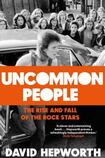
For sheer outlandish spectacle the mythic onstage feats of Iggy Pop rival those of any Cúchulainn. Lacerating himself with broken glass; walking on the audience’s hands while smearing himself with peanut butter; turning up for an audition with The Doors (post-Morrison) naked as the day he was born. Part of the reason fans get hooked on this stuff is because its essence is to defy the distinction between what’s performance and what’s real.
“I’m dying in a story,” Iggy crooned, “I’m only living to sing this song”. David Hepworth touches on this essence in his book. Fans’ “greatest investment is in the myth itself”, he writes, which can be “even more important than the songs you sing”.
Uncommon People: The Rise and Fall of the Rock Stars presents Hepworth's narrative of rock's history. It's a narrative that assumes rock to be, like cave painting, a thing of the past. Hepworth is a music journalist and editor who founded or edited a string of notable publications such as Mojo, Q, and Smash Hits and whose last book was the faintly dull 1971 – Never a Dull Moment: Rock's Golden Year.
Although Uncommon People has a promising premise – to orient rock's history around the centrality therein of freaks – his narrative quickly settles into the usual stale postures and platitudes. Much the same arc, not coincidentally, as we find in the careers of those stodgy male rockers to whom he's beholden.
Over 300 pages Hepworth tells the story, as he sees it, of rock’s rise and fall. For each year from 1955 to 1995, there’s a brief chapter focused on one artist and significant event. The year 1955, for example, focuses on Little Richard’s musical breakthrough; 1965, on The Who’s internal tiffs.
Once we’re out of the 1960s, though, rather than keeping his focus on new blood, Hepworth tends to stick with mainstream 1960s artists as they grow complacent, conceited and musty. This suits his narrative of nostalgia and decline and ignores the more vital rock musicians of recent decades.
Beefheart and Big Star
His 1986 shuns The Smiths for the frog-throated Dylan. His 1989 is summed up not by The Pixies, nor Sonic Youth, but Bonnie Raitt (!) No room at Hepworth’s cocktail party for tatty types like Beefheart or Big Star, or for abrasive women like Nina Hagen or PJ Harvey. No punk (Ramones, Sex Pistols, Slits), and nothing that’s not Anglophone (Serge Gainsbourg, Can).
If this book were an album, it would be one of those corporate Best Ofs that bunch a lot of familiar songs together in a characterless way and which are designed to lie at the bottom of a glove compartment.
You get the picture. If this book were an album, it would be one of those corporate Best Ofs that bunch a lot of familiar songs together in a characterless way and which are designed to lie at the bottom of a glove compartment.
Hepworth has two theses. The first is that rock apotheosises societal freaks. Rock stars are those who “had no reason to expect that they would ever be special” yet who also ‘”refused to accept that they would ever be anything but exceptional”. These are people who ascended society’s ladder usually without having typical advantages such as an expensive education or social connections. Hepworth’s second thesis is that the rock star as an animal is now dead, made extinct by the changing digital environment much like the polar bear will be made extinct by climate change. “The true rock stars rose and fell with the fortunes of the post-war record industry. They came along in the mid-fifties and passed away in the last decade of the century just gone.”
Lou Reed: typist
To back this up he gives some interesting anecdotes. Little Richard's Tutti Frutti, it turns out, was penned to celebrate sodomy. Lou Reed, after the split-up of The Velvet Underground, briefly tried his hand at being a square, taking a job as a typist. The account of Elvis's death is gloriously pathetic. Hepworth is at his best when writing about the 1950s, which in many ways remains rock's key period. But there's too much here that we've heard a million times before. Hearing once again the Cinderella story of how a then-unknown Jimi Hendrix got up onstage in London and jammed with Cream and wowed everyone has about the same effect as hearing some drunk blokes outside a pub singing Rod Stewart. And Hepworth's is indeed a bloke's eye view of history – women are rare and fleeting. Bowie sleeping with a 14-year-old girl is passed over without judgment.
It’s no coincidence that the advent of the rock star coincided with Warhol’s screen-print icons. Rock is a paradigmatic art of the mass-media age and, contra Hepworth, that age is still very much with us, even if the media and instruments continue to evolve. “On the air you could be anyone you wanted,” Hepworth says of how radio and TV enabled early rock. So long as young people still have the imagination and drive, our mass media age will continue to engender such mythic monsters and superfreaks.











